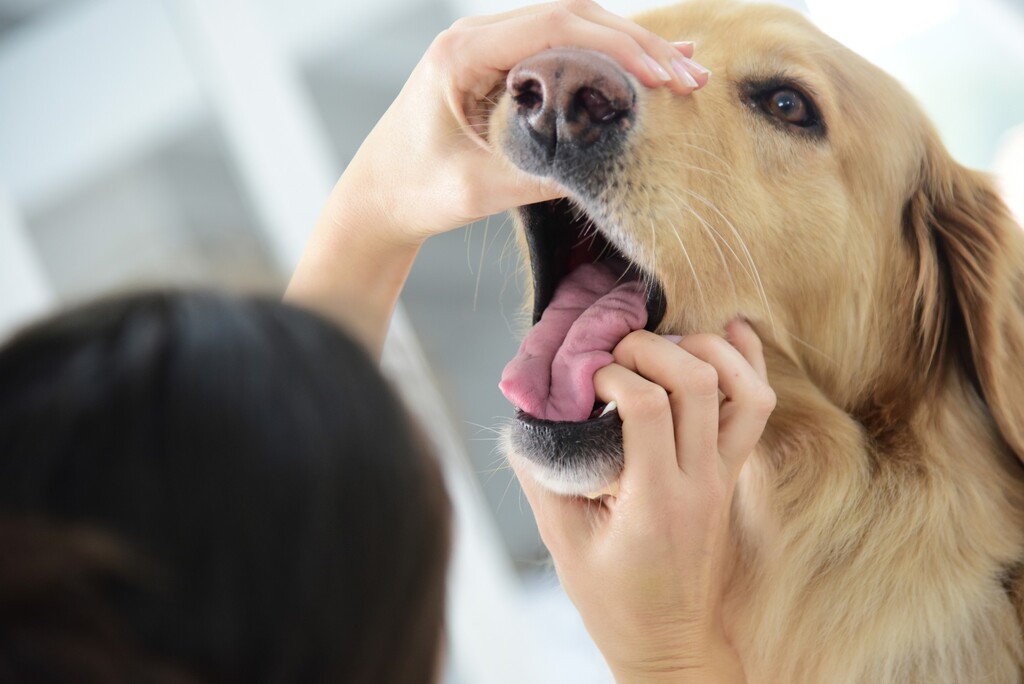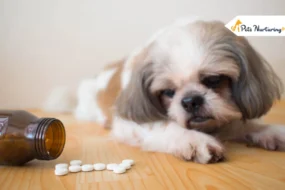
Has your dog eaten or swallowed something poisonous or dangerous? This happens with many dog-owners that while playing, their puppies usually drink or eat something that they shouldn’t have, such as a human medication, plastic toys, your other pet’s medication, or chocolate or raisins, which are very harmful to a dog’s health. In such a scenario, the first thing that you should always do is to contact your vet, and most of the time, they will ask you to induce vomiting in your dog. This way, he will throw up all the toxic or poisonous substances. Don’t know how to make a dog throw up? Don’t worry, keep on reading.
Introduction
Today in this blog, we’ve explained how to make your dog throw up and when it is not required. Read each paragraph carefully and learn what are the things that you should or shouldn’t do when your dog eats something toxic or dangerous.
Whether you have an adult dog or small puppies, they are always full of energy and not aware of their surrounding environment. So, either accidentally or out of curiosity; they end up with nearly everything in their mouths.
In that case, vomiting is one of the safest and easiest ways to save your pup’s life. That’s why it is extremely important to know when you should and when you should not induce vomiting and how to do it correctly.
If your dog has a history of seizures or it presently has problems with its stomach, throat, or breathing, or if two hours have passed since your dog has swallowed any poisonous substance, you should never make a dog vomit.
It can be harmful to its health. There’s a limited window of about 30 minutes between when a dog ingests the toxin and when he experiences severe complications for some poisons. So, you should also take care of that and try to make your dog throw up as soon as possible in these cases.
When to Make Your Dog Throw Up

First, you have to understand that you should only induce vomiting in a dog if it has recently ingested something poisonous. According to Gary Weitzman, author of the book, The Complete Guide to Pet Health, Behavior, and Happiness, “The most common reason we would recommend a dog vomit is if he’s eaten mouse poison or rat poison, or snail bait.”
He further explained, “Antifreeze and marijuana are other toxins for which vomiting is a necessary measure as well. Chemicals in gardens can cause issues for dogs, too.”
Now you might be wondering when is it safe to take my dog throw up? Here are some situations in which you can make your dog vomit, and it is completely safe:
- If your dog has recently swallowed a toxic substance and is not yet showing any signs of illness, it means he is asymptomatic. However, if it is more than two hours and still your dog is not showing any illness signs, which means that the substance likely hasn’t made it past his stomach yet.
- The swallowed substance is non-corrosive. Never try to induce vomiting with corrosive chemicals like battery, bleach, or concentrated oven or toilet or drain and bowl cleaners and lime removal products. They can burn the throat and cause more damage to the esophagus when it comes back up.
- The swallowed object isn’t too big or has no sharp edges as it can severely damage your dog’s throat and tear the esophagus or create a choking hazard when vomited.
- The swallowed toxic substance isn’t hydrocarbons or petroleum distillates such as kerosene, gasoline, or motor oil. They have a high risk of causing severe lung problems like aspiration pneumonia when accidentally inhaled.
When NOT To Make Your Dog Throw Up
There are some situations in which you should never try to make your dog vomit, as this can lead to severe health problems. Here are some situations and conditions:
- Don’t induce vomiting in your dog if it has swallowed acid, alkali, or household cleaning products. While vomiting, these substances can cause additional harm and could lead to even more damage on the way back up.
- Never try or force your dog to vomit if he swallowed a toxic substance and is already showing signs of illness. This means that the poison is already actively circulating through his system. At this time, you should always consult the vet.
- When your dog has already vomited, don’t try and make them vomit some more.
- Avoid inducing vomiting if your dog has swallowed food that includes bones, as the bones could get stuck on the way back up.
- Check the label of the substance or food your dog has swallowed. If that clearly states not to induce vomiting; there is no use of vomiting.

Only induce vomiting if your dog is healthy and isn’t at risk for inhaling the vomit into his lungs. Make sure that your furry friend doesn’t have any previous medical problems such as abnormal airway (laryngeal paralysis, collapsing trachea, etc.), an abnormal esophagus ( megaesophagus, etc.), or isn’t Brachycephalic breeds (English bulldogs, Pekingese, Shih-Tzus, Pugs, etc.).
NEVER try to induce vomiting in dogs using any of these methods
- Physically sticking a finger down the throat
- Mustard
- Salt (It can cause many side effects and results in a very elevated sodium level)
Again, we still recommend you check with your veterinarian or an animal poison control center first before inducing vomiting. You have to be very careful as this can cause more harm if you induce vomiting inappropriately, or sometimes it can be too late.
Now you’ve understood all the factors in which you should or shouldn’t induce vomiting in your puppy. Let’s move onto the most important part, how to make your puppy vomit.
How to Induce Vomiting in a Dog

When you’re completely sure that the substance which your dog has swallowed is not harmful and won’t cause any damage to its health, you can induce vomiting in your dog.
To start with the vomiting process, first, you need to serve the poisoned pup a small amount of food. This is not to reward your puppy for eating some spilled paint thinner or any other toxic substance; this food will help in diluting the poison and delay its absorption.
If your dog swallowed solid objects like socks, toys, this small amount of food would act as padding and lube when the item comes back up. Also, it can be tough to get a puppy to upchuck if its tummy is too empty.
Of course, you want to make your dog vomit in a way that won’t aggravate its condition while you’re trying to get rid of the poisonous substance. There are various ways to do it. Here are two scientifically backed substances that are safe to use in the home environment and also quite helpful in making a dog vomit.
Here are two methods:
Hydrogen Peroxide
The hydrogen peroxide solution is the most effective and safest way to induce vomiting in dogs. Every dog owner should keep on hand on this solution. In fact, many vets recommend it and often choose this method in their clinic. Because it’s easier to use and cheaper than apomorphine (The drug commonly used by vets to induce vomiting).
“A study found 3% hydrogen peroxide and apomorphine were almost equally effective for inducing vomiting in dogs. The possible adverse effects were also similar and mostly mild.”
To make this solution, you have to measure one teaspoon per every 10 pounds of your dog’s body weight. After making the solution, open your dog’s mouth and drop in the solution before massaging its throat. You can also use an eyedropper or small baster.
The peroxide solution will taste nasty and foam; however, this solution works like magic, and your puppy will vomit within five minutes. You can even repeat this dose two or three times, with a five-minute gap in each dose.
NOTE:
Hydrogen peroxide is not recommended for cats. So, NEVER try this solution to make your cats throw up.
Washing Soda Crystals

Another household product that can be used to make your dog throw up and save his life is a washing soda crystal (sodium carbonate). Don’t get confused with the caustic soda; both are different!
A study shows that washing soda is less effective in inducing vomiting than apomorphine. However, you can use it as it is a good alternative in an emergency situation and it’s easily accessible and cheap.
Many people also use syrup of ipecac to induce vomiting in dogs; however, we are not recommending it. This may be effective in inducing vomiting in children, but it may be toxic for your dog. Consult your veterinarian and ask whether this method is acceptable for your pet or not.
Are you wondering what to do after inducing vomiting in a dog? After your pup has emptied its stomach, call your vet. They’ll tell you whether you have to bring your pup in or not. Sometimes they also ask for a sample of the vomit to check the poisonous substance. Later, your vet will analyze the poison and offer an antidote or suggest other follow-up measures to ensure your puppy survives.
How to Make a Dog Feel Better After Vomiting
It is extremely important to make your dog feel better after it throws up. Here are some things you can do to make your puppy feel comfortable and relaxed:
- Always stay with your dog while you wait for it to throw up. You can help your dog walk around and even get him to bounce or jump a bit after you dose him. These movements and motions can encourage vomiting.
- If your dog hasn’t vomited within 10 minutes, you can give your puppy an additional dose of hydrogen peroxide.
- However, if it still hasn’t vomited even after a second dose. Head straight to the vet as they’ll give your dog stronger medication to make it happen.
- After your dog throws up, be sure to move your dog away from anything he vomits. Sometimes dogs immediately eat the substance that they have just vomited. Also, your vet may require your dog’s vomit for examination.
- Try to scoop your dog in your arms and gently rub its belly to provide your furry friend some comfort.
Keep Your Dog Safe & Healthy!
Making your beloved puppy vomit may look and sound unpleasant. But in an emergency, it is the best option for quickly removing a harmful substance or object from your dog’s throat and belly.

A moment or two of discomfort is way better than putting your dog’s life in danger!
The best way to deal with these kinds of situations is to prevent the problem from happening in the first place. Use child-proof locks on cupboards, keep sweet candy and pills out of reach, and always use puppy-proof holiday decorations. All these things and precautions will keep your baby dog safe.
We’ve described how to make a dog throw up after swallowing a foreign object using 3% hydrogen peroxide or washing soda crystals. These methods are safe and they make your dog vomit within a few minutes after the dose.
Still, you should always contact your veterinarian to discuss the situation before making your dog vomit at home and also visit him/her after your dog vomits. If your vet is closed, you can also contact an animal hospital or the Pet Poison Helpline.
Conclusion
So this is all about how to make your dog throw up. I hope you have found this blog helpful. Please share it with your friends and family who are also facing any pet health-related problems.
Keep reading:











